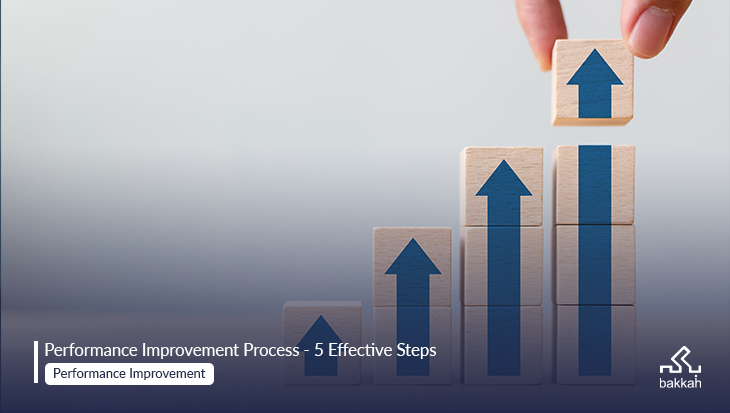Articles
Performance Improvement Process - 5 Effective Steps


Performance Improvement Process - 5 Effective Steps
Leading companies make sure to implement all success factors and elements, and because there’s no way a company can make it without dedicated employees, who harness exceptional performance and efforts to prosper and thrive in today’s challenging world, managers tend to follow the Performance Improvement Process which is one method to keep track of the flaws and fix the imperfections of employees’ performance.
Let’s read about PIP importance, cases where it is desperately needed and the steps to implement the Performance Improvement Process Plan effectively.
What is the Performance Improvement Process
Performance improvement belongs to the Performance Management category, and it is used by managers to help fix repetitive mistakes and elevate employees' productive and behavioral performance levels to live up to the expectations and meet the organization’s goals. Performance improvement occurs at a team level, department level, and organization level.
Why is the Performance Improvement Process essential
Unsatiating performance can occur due to many reasons and implementing a solution haphazardly without knowing the roots of the problem can result in serious risks.
Such a situation calls for a performance improvement process to be followed to come up with suitable solutions.
What is a Performance Improvement Plan - PIP
It is an official document approved by the employee’s HR and manager which states the steps needed to be taken by the employee to improve their performance.
There’s nothing hard about it, and employees should never feel frustrated because it has definite goals and deadline, so it should be no trouble to work with.
How to implement a PIP?
Some employees receive this document with so much destress, for they believe it is a red flag. They see it as sign of termination or demotion.
That’s why, HR’s need to take their time before deciding to use any performance improvement method. Study all aspects and reflect on the following points:
1- Does the situation require a PIP plan
Maybe it isn’t that brutal, maybe the employee has been going through some downs. Consider reaching out to them first to figure out if there’s any sort of help you could possibly provide.
If you saw no escape of issuing a PIP, go ahead! Your job is to keep work on track, and today’s competing world calls for highly attentive employees.
2- Stay objective during the monitoring process:
Subjectivity shall affect your decision with no doubts. Remember! You’re not only handling one-employee’s issue, but this going to affect the company’s performance and image as well. Evaluate the employee for its work only and take fair procedures.
3- Aid both the employee and the manager during the implementation of the process:
If it was inevitable, then let it be! However, be around during the process, cause employees will need a cheering voice to help them do better.
4- State clear goals, deadline, performance assistance criteria in the PIP:
You already have a lost soul, and your job is to provide them with a thorough document. Set clear, achievable, and realistic goals, and make sure the deadlines are flexible and suitable for the size of the tasks.
You don’t want them to end up performing poorly to meet the deadline. Finally, discuss the criteria they’ll be evaluated according to, this shall help them focus on improving these points.
When to implement a PIP?
Individual Performance Improvement Plans are most effective when performed when an employee is experiencing difficulties. Managers should be able to detect symptoms of underperformance in their employees. Some symptoms that an employee is struggling include decreasing productivity, decreased involvement, spending more time off, or being unpunctual. When there is a clear tendency of poor performance, the procedure should be initiated.
PIP is usually implemented in the following situations:
1- During an employee’s probationary period with the company:
It is easier to explain all the terms and expectations right from the start of the employment. This way, the employee can work towards the set goals and try to improve his performance by working on terminating his weaknesses.
2- If an employee has historically been an excellent employee but has recently demonstrated an abnormal tendency in low performance:
this is, of course, after you reach out to him to figure out if there’s a particular reason why their performance has become poor. Remember to remind the employee of how great addition his effort been to the organization and that you’ll help during the improving process.
3- When employee’s productivity start decreasing or they start to take more time off:
Productivity is basically what keeps the organization moving, so if the employee is not giving his best anymore, then this issue must be addressed right away.
What are the benefits of implementing a PIP?
Many organizations utilize performance improvement plans to review their workers' current performance and analyse the data to see how things may be done better.
You may get the following benefits from executing a performance improvement plan:
1- Keeping valuable employees:
Why bother with a tiring process of hunting talents and sorting CVs? A successful Performance Improvement Plan helps retaining your seasoned employees as they learn from their mistakes and work on the flaws.
This will show your employee how much you’re holding on to them, and they’ll do their best to live up to the expectations.
2- Skill Enhancement:
As business grows and blooms, employees’ skills need to be crafted and updated. You may not need to hire new staff if your performance improvement strategy identifies areas where additional education and training will be most beneficial to your present personnel.
3- Raise Your Expectations:
A performance improvement plan allows you to take a close look at your present standards and determine which ones should be raised.
Employees should be informed of the new business benchmarks because of these higher requirements.
4- Protection against charges of unjust or unlawful dismissal:
Have you ever heard the expression "if it wasn't written down, it didn't happen"? The key to performance concerns is paperwork and processes.
Without a performance management mechanism in place, it is difficult to dismiss without danger of being perceived as harsh, unfair, and unreasonable.
Effective Performance Improvement Process Steps
How can you improve the effectiveness of an Employee Performance Improvement Plan?
Some plans might not grant you the desirable results you hoped for. This might be attributed to a flawed planning or unclear set of goals. Here are 5 steps to increase the effectiveness of your PIP:
1- Set Clear Goals:
By providing clarity, the employee gains a complete grasp of their aims and ambitions. In contrast, failing to provide clarification will lead to increasing their perplexity.
Employees must be aware of their individual aims and ambitions. The more specific the goals, the easier it should be to achieve them.
2- Communication:
The employee Performance Improvement Plan is a team effort. Employees and managers alike should be allowed to freely discuss their current challenges as well as how they intend to attain the higher-level goals.
Employees may grow disenchanted and behave maliciously against the strategy. As a manager, make certain that your expectations are clear to the employee.
Keep in touch with your management as an employee to ensure that you are following the PIP as successfully as feasible.
3- Regular following-up:
Regular check-ins are very crucial in strengthening the efficacy of an improvement plan, almost as a prelude to the preceding point.
Regular check-ins give structure, but more importantly, they provide continuous guidance, which keeps staff on track.
4- Explain consequences vividly:
It is also critical to ensure that the employee understands that there will be obvious consequences if performance does not improve after applying the performance improvement plan.
There must be pre-defined, unambiguous, and visible repercussions specified in the first place.
5- Provide necessary training and assistance:
The whole point of improving performance is mending employees’ behavior in a specific sector.
This includes monitoring him and providing enough data on the parts he needs to work on.
Don’t underestimate the power of aiding your staff with new skills and enriching training. Remember, it is all for your company’s sake.
Regular check-ins, consistent assistance, and sufficient training will spare you the trouble of going through the whole Performance improvement process. However, when things get bleak, PIP shows the employees that you do care and that it is important to exert all possible efforts for the company’s sake. If you seek pro tips in Performance improvement, visit our website here.
.png)